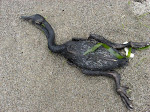Hummingbirds were a central theme of my recent Tucson trip. Southestern Arizona is serious hummingbird country, where 18 species have been seen, more than in any other state except Texas.

I attended a day of hummingbird talks and workshops on Thursday, viewed numerous Anna's and black-chinned hummingbirds on Friday, and presented data from our New Mexico black-chinned hummingbird studies, including the climate change slide above, on Saturday.
On Sunday morning, I woke at 4:20 and drove from my friends' house in north Tucson to parking lot of Sabino Canyon in the Santa Catalina Mountains.

The desert morning was beautiful. The birdsong and sunlight on the cacti were well worth the sleep deprivation.
Another visiting hummingbird biologist and I joined volunteer bander Elissa Fazio, her intern, and two volunteer assistants for a morning of trapping.

The banding area was a perfect blend of riparian and desert scrub habitats, attracting numerous birds such as the Bell's vireos that were singing all around us.

We set up traps around two large feeders in a grove of large Gooding's willows along the Creek.

The traps consited of a circular curtain that could be raised and lowered over the trap. When a bird landed to feed, the curtain was dropped and we reached in to remove the birds, place them in a bag, and deliver them to Elissa for identification and banding.

The birds were identified, sexed, and banded. Before releasing the birds Elissa and her intern gave them a drink from the feeder. We snapped numerous photos as the little birds gained their bearings before buzzing away.

We captured a female Anna's hummingbird, a species currently found both in Portland and Tucson following a rapid range expansion.

Black-chinned hummingbirds nest in riparian woodlands throughout the western US. We captured several females and one male, above. Since this is one of my "study species" I was happy to see them up close once again.

My favorite species of the day was the broad-billed hummingbird. The Santa Cruz watershed, which surrounds Tucson, is the northern limit of their breeding range. Broad-bills nest in riparian woodlands and adjacent desert scrub.

Males and females have pink bills with black tips. You can see from this photo where they get their name.

We all oohed and awed at the brilliant males broad-bills. Even Elissa, who has banded hundreds of these little guys could not get over their good looks.
After a busy couple hours of banding, the birds slowed their activity as the morning began to warm. My flight departed at noon, so I left the operation early to drive to the airport. I could not ask for a better way to end my trip.

















































